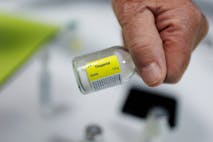
Euthanasia rates are higher in one part of Canada than anywhere else. Why?
Bridget Sielicki
·
Despite claims to the contrary, assisted death is suicide and it is a tragedy
As the call to make assisted suicide legal in the United Kingdom gains popularity, one advocate is publicly making the claim that assisted death isn’t the same as suicide. In a recent opinion piece for The Mirror, Marjorie Wallace claims, “Shortening life and shortening death isn’t the same and a clear distinction must be made between them.”
Wallace, chief executive and founder of the mental health charity SANE, isn’t the first to make this claim. But her opinion is a dangerous misdirection about the truth of what assisted suicide really is: the decision to take one’s own life, often due to loneliness, depression, and despair. Ultimately, the choice to end one’s life — whether due to terminal illness or some other reason — is suicide.
Assisted suicide isn’t compassionate — it’s a cry for help
In her editorial, Wallace writes, “To conflate shortening life with shortening death does a disservice to both suicide prevention and to end-of-life care. Recognition of this distinction and an appropriate use of language are vital if we are to ensure that everyone receives compassionate care for their individual needs throughout their life, as well as at its end.”
Wallace’s claim that assisted death is somehow compassionate misses the mark. Many studies have shown that people who ask for assisted suicide do so because they are depressed, hopeless, have no support, and are afraid of being a burden — not because they are seeking to prevent pain. Strikingly, these are many of the same reasons that people who are not terminally ill commit suicide. When someone is suffering in this way, it isn’t compassionate to kill them, but instead to offer them help, support, assistance, and care. Studies have shown that this can be highly effective, with one report finding that 72% of older people who expressed a wish to die had changed their minds within two years after their feelings of loneliness and depression had improved.
In addition, the idea of offering someone a compassionate way to die brings to mind an image of a calm, peaceful death, but often the experience is the opposite. People who choose assisted suicide often express a desire to have control over their death. But in reality, it is nearly impossible to have full control over those final moments. One Colorado woman recently spoke of the horrible process of her husband’s assisted suicide, which left him choking, coughing, and gasping for breath for hours.
READ: British peer argues: People with disabilities need help living, not dying
Her experience was far from unusual. Researchers in the Netherlands have found that one-third of assisted suicide patients suffered prolonged and painful deaths that took more than 30 hours. In some horrifying cases, patients who weren’t able to swallow the complete dose of the barbiturates that cause them to die were left paralyzed yet conscious and aware as their bodies slowly went into organ failure. No one should be advocating for such a death.
Article continues below
Dear Reader,
In 2026, Live Action is heading straight where the battle is fiercest: college campuses.
We have a bold initiative to establish 100 Live Action campus chapters within the next year, and your partnership will make it a success!
Your support today will help train and equip young leaders, bring Live Action’s educational content into academic environments, host on-campus events and debates, and empower students to challenge the pro-abortion status quo with truth and compassion.
Invest in pro-life grassroots outreach and cultural formation with your DOUBLED year-end gift!
A terminal illness isn’t always terminal
While Wallace champions assisted suicide, she is quick to note that her organization, SANE, is against the idea of euthanasia and assisted suicide ever being allowed for anyone without a terminal illness. The problem with this thinking is that it is extremely difficult for doctors to really know whether or not an illness is “terminal,” and nearly impossible for someone to accurately predict how much time a person has left.
Many palliative care doctors have spoken out against assisted suicide for this reason. Ilora Finlay, a leading doctor in Ireland, has said that she has worked with people whom she thought had just weeks left, but instead went on to live for years. Live Action News has previously reported on Vicki Walsh, a woman who lived for years after being told she would die within months, and Colin Clark, who considered assisted suicide after a brain cancer diagnosis but eventually got well enough to start running triathlons. According to medical professionals, these people were facing imminent death. However, they both defied the odds and continued to live for years. With the proper care, even chronically ill people can continue to live long and happy lives despite a doctor’s diagnosis.
The ripple effects are the same
When a person takes their own life — whether by assisted death or suicide — the ripple effects are the same. Friends and loved ones feel the loss keenly, especially when it’s a loss that occurs because a person took his own life. Family members of those who have killed themselves through assisted suicide have spoken out about the tragedy it is, with one woman saying, “Campaigners for assisted dying underestimate how terrible it is for those of us left behind.”
While assisted suicide advocates claim that it is merely a dignified way to control death, studies have shown that when medical professionals play a role in another’s death, their own psychological and emotional health is adversely impacted. One report says that euthanasia causes “deep distress” to the doctors who commit it. Many doctors also oppose assisted suicide and euthanasia for that reason.
The argument that suicide and assisted death are fundamentally different sends the message that it’s worthwhile to fight for people struggling with depression and mental illness — unless those people are suffering a terminal illness. Instead of advocating for easier access to death, more people should advocate for funneling money and resources into better palliative care and mental health resources, in a truly compassionate effort.
“Like” Live Action News on Facebook for more pro-life news and commentary!
Live Action News is pro-life news and commentary from a pro-life perspective.
Contact editor@liveaction.org for questions, corrections, or if you are seeking permission to reprint any Live Action News content.
Guest Articles: To submit a guest article to Live Action News, email editor@liveaction.org with an attached Word document of 800-1000 words. Please also attach any photos relevant to your submission if applicable. If your submission is accepted for publication, you will be notified within three weeks. Guest articles are not compensated (see our Open License Agreement). Thank you for your interest in Live Action News!

Bridget Sielicki
·
Analysis
Cassy Cooke
·
Analysis
Cassy Cooke
·
Analysis
Cassy Cooke
·
Analysis
Nancy Flanders
·
International
Angeline Tan
·
Politics
Bridget Sielicki
·
International
Bridget Sielicki
·
International
Bridget Sielicki
·
International
Bridget Sielicki
·
Human Rights
Bridget Sielicki
·